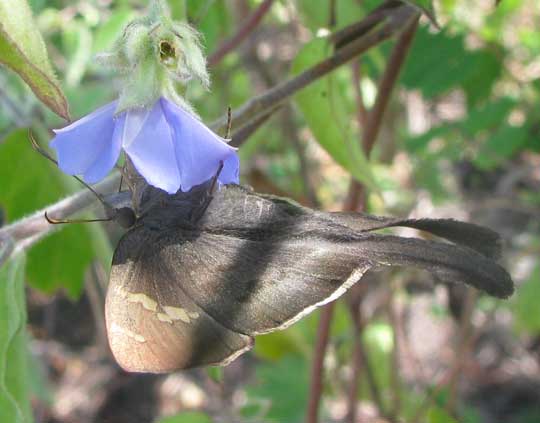Excerpts from Jim Conrad's
Naturalist Newsletter

from the October 24, 2010 Newsletter issued from Hacienda Chichen Resort beside Chichén Itzá Ruins, central Yucatán, MÉXICO; limestone bedrock, elevation ~39m (~128ft), ~N20.676°, ~W88.569°
LONGTAIL SKIPPER OF UNDERSIDES
Around noon on a hot, sunny day when all the world seemed in the mood for a siesta, suddenly a nervous little packet of energy flitted by and landed upside- down beneath a Jacquemontia's blue flower, as seen below:

Before he got away I put the camera beneath the down- hanging blossom and shot skyward, hoping the camera's automatic focusing was working, and got the shot at the top of this page.
We've had longtail skippers before, but this one struck me as different. You might enjoy savoring variations on a longtail skipper theme by comparing the shot at the top of the page with the White-tailed Longtail shown at www.backyardnature.net/yucatan/mariposa/butt032.jpg.
Bea in Ontario pegs our new longtail skipper as the widely distributed Asine Longtail, POLYTHRIX ASINE*, native from northern Mexico (rarely wandering into southern Texas) south to Perú. I read that its caterpillars eat leaves of members of the Bean Family, which are abundant here, and live in nests formed of rolled or tied-together leaves.
Also I read that adult Asine Longtails land with their wings spread across the undersides of leaves. That's exactly what I saw myself, and it's worth noting that in the picture the skipper is feeding upside-down as well. From my limited experience with this species it looks like it specializes on the undersides of things.
That's interesting, because it's a basic tenet of population ecology that two taxa can't occupy exactly the same ecological niche for long without one species eventually displacing the other. If one of two otherwise identical species visits upright flowers while the other goes to dangling ones, that's enough to maintain both species in the same area. I don't know that that's the case with the Asine Longtail and its look-alike fellow longtails, but the concept comes to mind when you see this one's passion for undersides.